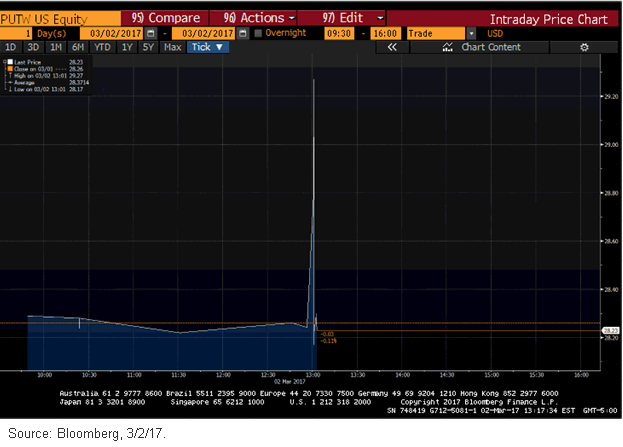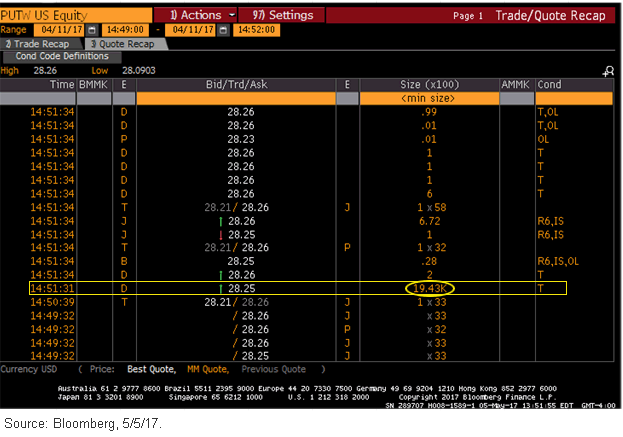ETF Execution: Your Choice Matters
The spectrum of sophistication among exchange-traded fund (ETFs) users ranges from new users of ETFs who are just learning and realizing their many benefits to those users who utilize ETFs on a daily basis and incorporate them into their portfolios. No matter where an investor is on this spectrum, what is paramount is to recognize that ETF execution affects your total return. Investors spend the majority of time on asset allocation, but when it comes time to execute, it is imperative to know what resources you have to obtain the best pricing possible.
Let’s take a look at two trades as the best way to understand the impact your execution choices can have on your bottom line.
(Click on image to enlarge)

Figure 1 shows an investor, Investor A, who wanted to buy 25,000 shares of the WisdomTree CBOE S&P 500 PutWrite Strategy Fund, PUTW. Investor A was unclear of what his resources were and did not feel like asking for assistance. He ended up entering a market order causing PUTW to spike 3.6%. PUTW is an investment vehicle—as opposed to a trading vehicle—so while there is ample liquidity available via the underlying securities, it is imperative to know how to access it and to not just enter a market order. PUTW’s underlying securities are S&P 500 Index put options, some of the most heavily traded options in the marketplace, as they derive their liquidity from the components of the S&P 500. This trade could have potentially been executed without any market impact.
So what could have been prevented? We always recommend that clients use a limit on all orders, instead of a market order, as a form of protection to ensure that their orders do not get filled outside a specific comfort zone. This is a clear example of how a limit is always encouraged, no matter the size of the order. The underlying securities of PUTW are extremely liquid, and had the investor made a simple phone call and used his resources, which will be discussed later, this could have been easily avoided. No size is ever too small to reach out to the capital markets team or your trading desk.
The second trade example, in figure 2, shows another investor, Investor B, who also wanted to purchase PUTW. On the opposite end of the spectrum, Investor B wanted to purchase 1,942,500 shares of the Fund, a MUCH larger chunk than Investor A.
Figure 2
(Click on image to enlarge)

As you can see, Investor B was able to purchase his entire order, which was almost 20 times the average daily volume, at one penny inside the offer in a single block. His execution was flawless. He was able to take advantage of the ETF structure by using his resources. The client reached out to the capital markets desk here at WisdomTree for a consultation on his trade and then was able to lean on his trading desk to implement his order. His trading desk was able to work with
to tap into the underlying liquidity of PUTW. Investor B was not an expert trader, but he realized that he needed to utilize his resources to ensure a smooth execution experience. This trade example illustrates clearly that liquidity exists beyond what is on screen, and there are expert market makers who can access that resource and pass it back to the investor.
This brings me to the obvious question: Would you rather have the execution experience of Investor A or that of Investor B? I think we can all agree we would much prefer Investor B’s seamless execution experience.
Disclosure: Neither WisdomTree Investments, Inc., nor its affiliates, nor Foreside Fund Services, LLC, or its affiliates provide tax advice. All references to tax matters or information provided ...
more


